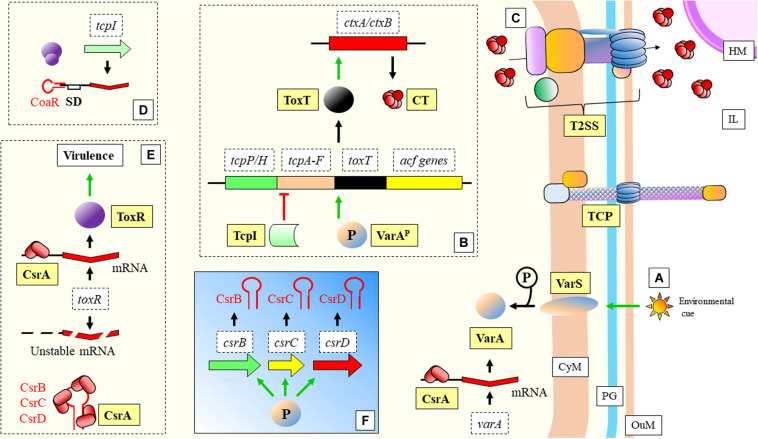FIGURE 7.
Vibrio cholerae: mechanisms of virulence and regulation. (A) Environmental cues trigger the signalization in the two-component system VarS/VarA (functional homologs to the GacS/GacA two-component system of P. aeruginosa). Phosporilation of VarA activates this protein. Transcription of varA is facilitaded by CsrA. (B) VarAP (activated) acts as a transcriptional activator of toxT. ToxT activates as well ctxA/ctxB encoding the two subunits of the CT protein, which is extruded to the IL through a T2SS (C). The tcpA gene, required for the assembly of the TCP, is located in the same operon as toxT. TcpI is a transcriptional inhibitor of tcpA. TCP structure is necessary for the progression of the disease (bacterial aggregation and microcolony formation). (D) CoaR sRNA blocks binding of the ribosome to the tcpI mRNA. (E) CsrA stabilizes toxR mRNA, which is necessary for positive regulation of virulence genes. (F) VarAP activates transcription of CsrB, CsrC, and CsrC sRNAs, which sequester CsrA, yielding an unstable toxR transcript. CT, Cholera toxin; CyM, Cytoplasmic membrane; HM, Host cell membrane; IL, Gastrointestinal lumen; OuM, Outer membrane; PG, peptidoglycan; T2SS, Type II secretion system; TCP, Toxin coregulated pilus. Black thick arrows indicate flow of a biological process, e.g., protein translation. Green thick arrows indicate activation. Red thick arrows with flat cap indicate inhibition. References: Hammer and Bassler, 2007; Jang et al., 2011; Cobaxin et al., 2014; Mey et al., 2015; Ng et al., 2016; Dorman and Dorman, 2018; Jemielita et al., 2018; Butz et al., 2019; Xi et al., 2020.

